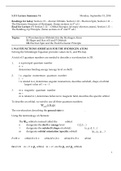Exam (elaborations)
Principles of Chemical Science_Hydrogen Atom Wave functions (Orbitals) - Lec6
- Course
- Institution
Lecture 6: Hydrogen Atom Wave functions (Orbitals) 1. Wavefunctions (Orbitals) for the Hydrogen Atom 2. Shape and Size of S and P Orbitals 3. Electron Spin and the Pauli Exclusion Principle
[Show more]



